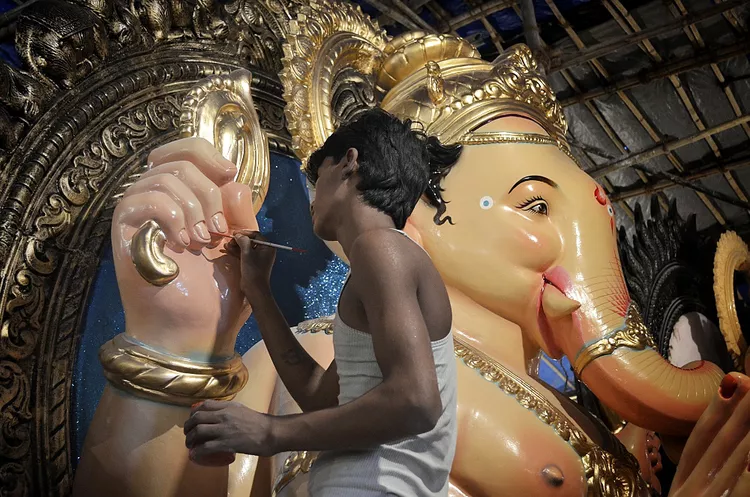1. Handcrafting Lord Ganesh for the Festival
2. Inside the Idol Workshop
3. Rows of Ganesh Idols
4. Ganesh Idols Ready for Sale
5. Metallic Ganesh Idol Being Painted
6. Large Ganesh Idols Being Made
7. Some Idols Required Scaffolding
8. Rows of Mice
9. Everyone Was Busy
10. Putting the Final Touches on the Idols
11. Kambli Arts
12. Roadside Sculpting of Ganesh
13. Lalbaug Spice Market
Picture this.
There are only a few weeks remaining until the Ganesh Chaturthi Festival in Mumbai. It is one of the city’s largest and most eagerly anticipated festivals of the year. More than 200,000 idols of Lord Ganesh will be worshiped and immersed in water over the 10 days of celebrations. Artisans are busily working at workshops in south Mumbai’s Lalbaug district, racing against time to complete all the idols. The intricate process of handcrafting these idols has been ongoing for approximately three months, relying on specialized skills passed down through generations. Workers often travel from as far as Bihar to participate.
Wanting to witness the creation of Lord Ganesh firsthand, I decided to embark on a Ganpati Bappa Morya guided walk, offered by Breakaway.
My guide for this intriguing adventure was Ramanand Kowta (cell phone: 9892910023), a multitasking individual with a diverse background. He entered the tourism industry ten years ago after completing a lengthy corporate career followed by time in organic farming. What struck me was his remarkable spiritual insight and photography skills.
Inside the Idol Workshop
With great anticipation, we headed to one of the largest idol workshops in the area. Located north of the Lalbaug Flyover, it was a large makeshift shed constructed from bamboo poles and blue tarpaulins behind iron gates.
Rows of Ganesh Idols
Inside, various sizes and designs of idols sat in orderly rows, each at different stages of completion.
Ganesh Idols Ready for Sale
Some completed idols were wrapped in plastic, awaiting their new homes.
Metallic Ganesh Idol Being Painted
Others were in the process of receiving their distinctive metallic silver appearance.
Large Ganesh Idols Being Made
Many larger idols were still being shaped out of plaster, towering impressively over us.
Some Idols Required Scaffolding
One idol, sitting atop a massive base, was surrounded by scaffolding permitting artisans to access its upper parts.
Rows of Mice
The mouse, often referred to as Lord Ganesh’s “vehicle,” was also being crafted. They were lined up neatly in rows.
Everyone Was Busy
We observed people engrossed in painting while others carried large bags of supplies.
Putting the Final Touches on the Idols
I couldn’t help but wonder if the artisans would finish in time for the festival. The detailing required to transform the plain idols into the much-adored form of Lord Ganesh is quite extensive.
Kambli Arts
Near Chinchpokli Bridge, we visited the workshop of Ratnakar Kambli, head of Kambli Arts. This family has been creating Mumbai’s most renowned idol, the Lalbaugcha Raja, since 1935. For them, idol making transcends profit; it embodies devotion, with decoration occupying their time for the rest of the year.
Mr. Kambli graciously welcomed us with cold drinks and shared laminated photos of the Raja. The impressive idol, although fully assembled, had yet to be painted, requiring about one and half months to finish. Its parts are cast from molds in the workshop and then transported to a secure site in Lalbaug market, as it is too large to move as a whole. The idol’s iconic design, now patented, was developed by Mr. Kambli’s older brother, a graduate of the Sir J. J. School of Arts, and its elaborate set comes from collaborations with notable designers, including Bollywood art director Nitin Desai.
He also mentioned that adaptations have been made to the design of Lalbaugcha Raja to fit under the new Lalbaug Flyover for immersion. Some parts, such as the crown, are designed to fold down.
Throughout the workshop, artisans who had worked late into the night napped on bedrolls beneath statues of the Lord. Despite the noise and activity, they seemed at peace.
Roadside Sculpting of Ganesh
In other workshops sprinkled along the roadsides, young craftsmen were diligently sculpting and painting. Some were still mere teenagers, demonstrating impressive skills in this sacred art.
Lalbaug Spice Market
My journey concluded in the Lalbaug spice market, where I left feeling uplifted and unburdened by this divine experience that brought me closer to Lord Ganesh, the remover of obstacles. The creative expressions dedicated to him and the dedication visible in their creation were truly inspiring.
The idols of Lord Ganesh will be displayed and worshiped in homes across the city during the festival. Ultimately, they will be immersed in water, signifying a powerful lesson in non-attachment and the reminder that the Lord’s essence remains even when his image fades.





